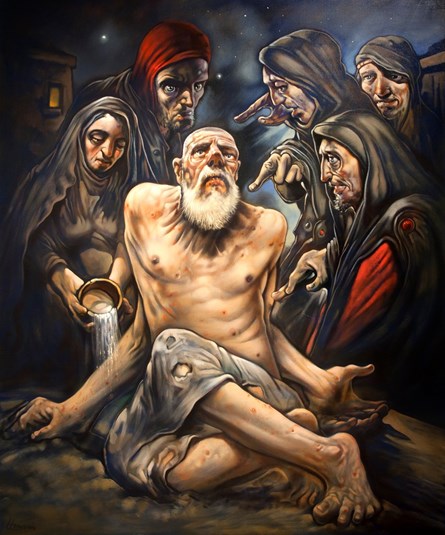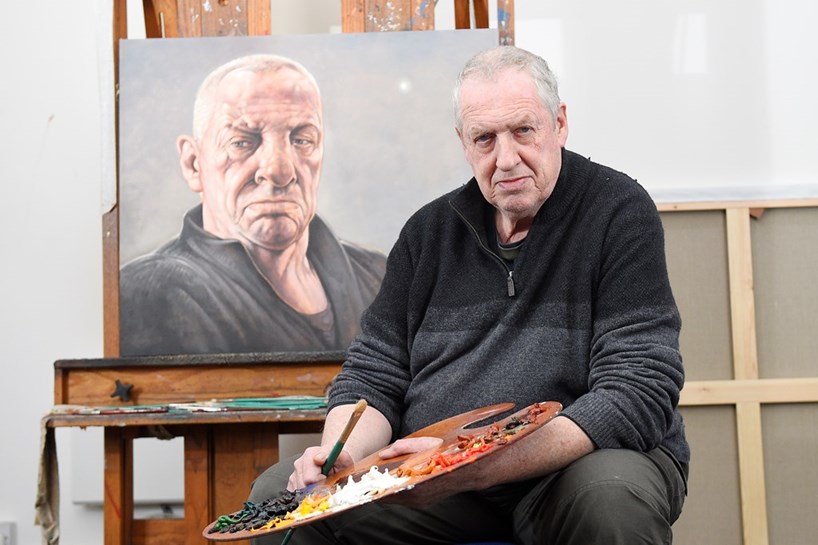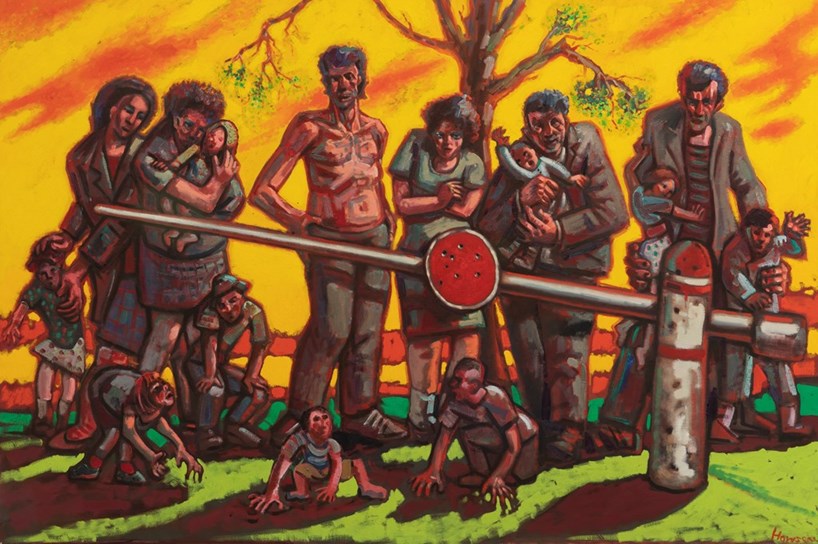FOR this retrospective, Peter Howson has painted a self-portrait, his first since 2008. He paints himself in serious and stoical mode, eyes glancing right, looking beyond the edge of the canvas. He says of this image: “I hope it captures something of the madness and obsession of an artist’s life. Going in and out of the underworld does tend to leave scars and burnings.”
Howson experienced bullying as a child at school and again later during a short spell in the army. After achieving fame as an artist, he abused drink and drugs while experiencing significant periods of mental distress. These peaked after experiences as a war artist in Bosnia, and this led eventually to the AA 12-step programme, a vision of Jesus, and conversion to Christianity.
While his faith has remained strong, life since has continued to be an emotional rollercoaster, leading to his talk of scars, burnings, and going in and out of the underworld. He also says of this self-portrait, however, that “The human body and the face are beautiful in every way — miracles really, showing a glimpse of God in everyone.” These twin poles represent his beliefs and have come to characterise his work.
Howson came to prominence as one of the New Glasgow Boys in the 1980s, through the promotion of Sandy Moffatt, a tutor at the Glasgow School of Art; and the exhibition begins with two works from 1985 based on his army experiences.
 © Peter Howson, courtesy of Flowers Gallery, photo Antonio ParentePeter Howson, Job (2011), oil on canvas, 182 x 152 cm, Alan and Karen Turner
© Peter Howson, courtesy of Flowers Gallery, photo Antonio ParentePeter Howson, Job (2011), oil on canvas, 182 x 152 cm, Alan and Karen Turner
As Susan Mansfield notes in the catalogue, he became known for images of “tramps and boxers, hard men and hooligans”, with a dialogical response based on a recognition of his own attraction to violence while also abhorring its effect. St Paul’s confession that he did not do the good that he wanted, but the evil that he did not want was what he did, has been Howson’s own experience. He paints himself as Jekyll and Hyde in somewhat cartoonish style, to express the duality of his own persona. But his drawing The Double Nature of Burns more effectively captures the struggle of living life and feeling big, dark emotions.
As a result of this personal understanding, he empathises with those who are similarly troubled, while expressing significant concern about those who use commitments such as football or patriotism as a veneer for violence. In images such as The Heroic Dosser, he gives dignity to people on the edge of society, while also acknowledging, in a series such as The Blind leading the Blind, ways in which powermongers, to support their own selfish ambitions, manipulate emotions to stir up violence between groups.
He uses expressive styles that draw on the expressionism of Max Beckmann and Otto Dix, while increasingly being inspired by the work of Pieter Bruegel the Elder, Hieronymus Bosch, William Blake, and Francisco Goya.
Such understandings were amplified through his experiences of being a war artist in Bosnia, where his style became looser and more expressive in response to the trauma seen and heard about in the war zone. These experiences then also left their mark on his psyche as he struggled to assimilate the horrors of that particular conflict and readjust to his normal life.
He depicted scenes he experienced such as Sanctuary in Travnik, where Muslim refugees arrive in safe territory, while experiencing new challenges on arrival, but also depicted scenes including, controversially, the rape of women by soldiers. Howson rarely works directly from life, usually transmuting scenes through imagination to find his truth and reality. His Bosnian images are stark portrayals of the depths to which human beings can sink in their abuse of others in wartime.
 Greg McVeanPeter Howson with his Self-Portrait (2023), in his studio in Glasgow
Greg McVeanPeter Howson with his Self-Portrait (2023), in his studio in Glasgow
His particular vision seems attuned most acutely to the nuances and dynamics of violence, and this informs the latter half of his career, when Christianity, which had previously featured within his work, comes to the fore, both in religious iconography and apocalyptic images.
His images of Christ and of personal salvation seem somewhat stylised in the Transfiguration or Road to Damascus, but are full of originality and energy in The Last Supper or a Backstreet Crucifixion. These latter images benefit from contemporary settings: The Last Supper shows the disciples as rogues rather than saints and grouped like card sharks around the central Christ figure.
Images depicting faith as a journey generally make a greater impact than those that suggest arrival. Images in which Howson’s daughter Lucie guides him as a Christ-figure through the vicissitudes of the world are particularly moving; Acheron, where Lucie is at his side on a boat, Lucie, while navigating in Hades, or A Singular Road, in which Howson carrying Lucie is equated to St Christopher carrying Christ. Howson’s Stations of the Cross, which focus solely on faces, are also original in conception and moving in execution.
Howson’s vision has always been apocalyptic, but has become increasingly so in recent years, when the harrowing of hell has become a particular inspiration. The crucified Christ frequently appears in Hades surrounded and increasingly swamped by a writhing swarm of sinful humanity, as in the large oil painting Prophecy. Howson’s prophetic warning is one of fearing that humanity’s desire to inflict violence and abuse will increasingly dominate society, both relationally and politically. During the Covid pandemic, such images became overwhelmingly post-apocalyptic depictions envisaging the triumph of evil, should it occur.
In a primarily secular age, when art critics and curators for many years ignored the religious influences of artists, Howson is a surprising and unsettling artist. To be fully understood and appreciated, his work needs to be set within the Northern Romantic tradition and specifically the Expressionism and Magic Realism of Germany between the world wars.
 © Peter Howson, courtesy of Flowers Gallery, photo Antonio ParentePeter Howson, Barrier Sunset (1995), oil on canvas, 122 x 183 cm, Flowers Gallery
© Peter Howson, courtesy of Flowers Gallery, photo Antonio ParentePeter Howson, Barrier Sunset (1995), oil on canvas, 122 x 183 cm, Flowers Gallery
While personal circumstances have brought him to his particular vision, he is, nevertheless, part of a large group of artists in the modern period who found contemporary expressions for traditional religious iconography. Others, such as Louis Carreon and Joe Machine, have shared life and art changes from addiction or criminality to God within their work, while emerging artists, such as Lakwena Maciver, Egbert Modderman, and Genesis Tramaine, have been as upfront about their faith as Howson.
His apocalyptic focus also means that it would not be inappropriate to view his work to an accompaniment of songs from Bob Dylan. Appreciating Howson’s achievements within these frames of reference enhances understanding of his originality, inspirations, and, ultimately, the challenge that he poses to us all.
The title of the exhibition, “When the Apple Ripens”, hails directly from a phrase used by Dr David Donaldson at Glasgow School of Art’s painting department.
Howson explains: “The first time I heard this saying was way back in 1979 at Glasgow School of Art. My friend Ally Thompson, the artist, told me it was one of Dr David Donaldson’s favourite bits of advice to students in the painting department. When he found a student footering about with an oil painting, or unable to finish it, he would say ‘When the apple ripens’ — pause — ‘don’t pry!’ It’s always been one of my favourite memories of my friendship with Ally and hearing him mimic David Donaldson saying it to bewildered students.”
This retrospective is evidence that, in Howson’s case, the apple has ripened and that he has created a substantial body of original and challenging work. When I interviewed Howson in 2018, he spoke about his personal journey, saying: “I am an addictive, hedonistic person by nature. That is destructive to me, and it is bad for the people around me, so I force myself to work, and walk and pray. It’s been a long road, with many wrong turnings, but I’ve never felt that it wasn’t worth it. I believe that I am walking towards something incredible.”
He was probably speaking then of heaven, but this exhibition reveals his body of work to also be an incredible achievement — an achievement that we are fortunate to be able to witness.
“When the Apple Ripens: Peter Howson at 65: A Retrospective” is at the City Art Centre, Edinburgh, until 1 October. www.edinburghmuseums.org.uk